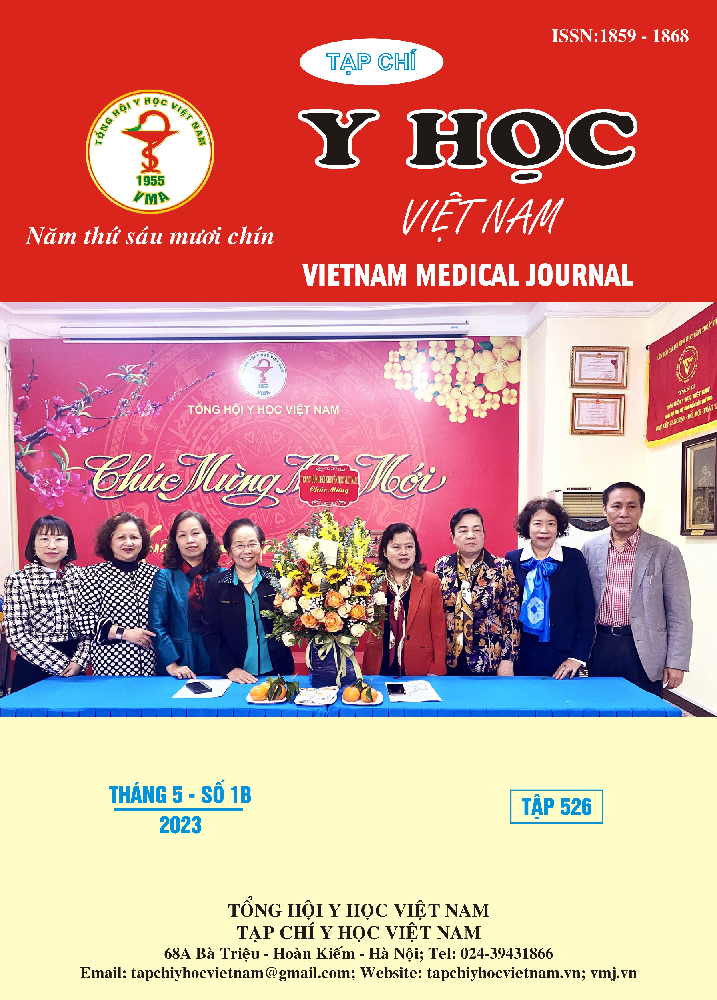SOME FEATURES OF CINGULUM TRACT ON DIFFUSION TENSOR IMAGING OF VIETNAMESE ALZHEIMER PATIENT
Main Article Content
Abstract
Objective: To reconstruct Cingulum tract (CGT) in Vietnamese Alzheimer patients (AD) by using Diffusion tensor imaging (DTI). Subject and method: Cross-sectional study. We reconstructed the white matter (WH) fibers of CGT of 20 Vietnamese Alzheimer patients and 20 normal subjects (NS) by using DTI. Result: The mean (± SD) age of AD patient and NS was: 69,05±7,77 years and 69,70±5,83 years (no significant difference, p=0,76); the age of AD onset was: 64,65±7,18 years; MMSE score: 12,20±7,35; Male/female (AD/NS) was: 8/12 and 9/11. The mean (± SD) number and length of fibers, voxel, FA and ADC of the right CGT (AD and NS) were: 461,15±307,22 fibers and 268,45±132,09 fibers; 65,43±14,20 mm and 66,35±11,31 mm; 312,50±138,39 voxels and 238,25±69,27 voxels; 0,34±0,03 and 0,36±0,02; 0,76±0,10 and 0,77±0,07 (respectively). Of that, the number fibers and voxel of AD was significantly higher (p=0,01 and p=0,04, respectively), FA was significantly lower in AD (p=0,00). The length of fibers and ADC had no significant difference (p>0,05). The mean (± SD) number and length of fibers, voxel, FA and ADC of the left CGT (AD and NS) were: 506,90±287,29 fibers and 392,40±174,96 fibers; 71,91±17,58 mm and 75,57±9,64 mm; 349,55±131,10 voxels and 306,60±70,85 voxels; 0,35±0,03 and 0,39±0,02; 0,78±0,11 and 0,76±0,05 (respectively). Of that, the number and length of fibers, voxel and ADC had not significantly difference; FA of AD group had significantly lower (p=0,00). Conclusion: the result of reconstructing CGT by using DTI suggest that: microstructure changes in white matter integrity in Vietnamese AD patients. More comparative studies are needed.
Article Details
Keywords
Cingulum tract, DTI, Alzheimer disease.
References
2. Basser PJ, Mattiello J, LeBihan D. Estimation of the effective self-diffusion tensor from the NMR spin echo. J Magn Reson B. 1994;103(3):247-54.
3. Bubb EJ, Metzler-Baddeley C, Aggleton JP. The cingulum bundle: Anatomy, function, and dysfunction. Neurosci Biobehav Rev. 2018;92:104-27.
4. Mori S, van Zijl PC. Fiber tracking: principles and strategies - a technical review. NMR Biomed. 2002;15(7-8):468-80.
5. Braak H, Braak E. Frequency of stages of Alzheimer-related lesions in different age categories. Neurobiol Aging. 1997;18(4):351-7.
6. Schupf N, Kapell D, Nightingale B, Rodriguez A, Tycko B, Mayeux R. Earlier onset of Alzheimer's disease in men with Down syndrome. Neurology. 1998;50(4):991-5.
7. Catheline G, Periot O, Amirault M, Braun M, Dartigues JF, Auriacombe S, et al. Distinctive alterations of the cingulum bundle during aging and Alzheimer's disease. Neurobiol Aging. 2010;31(9):1582-92.
8. Stenset V, Bjørnerud A, Fjell AM, Walhovd KB, Hofoss D, Due-Tønnessen P, et al. Cingulum fiber diffusivity and CSF T-tau in patients with subjective and mild cognitive impairment. Neurobiol Aging. 2011;32(4):581-9.
9. Wong D, Atiya S, Fogarty J, Montero-Odasso M, Pasternak SH, Brymer C, et al. Reduced Hippocampal Glutamate and Posterior Cingulate N-Acetyl Aspartate in Mild Cognitive Impairment and Alzheimer's Disease Is Associated with Episodic Memory Performance and White Matter Integrity in the Cingulum: A Pilot Study. J Alzheimers Dis. 2020;73(4):1385-405.


